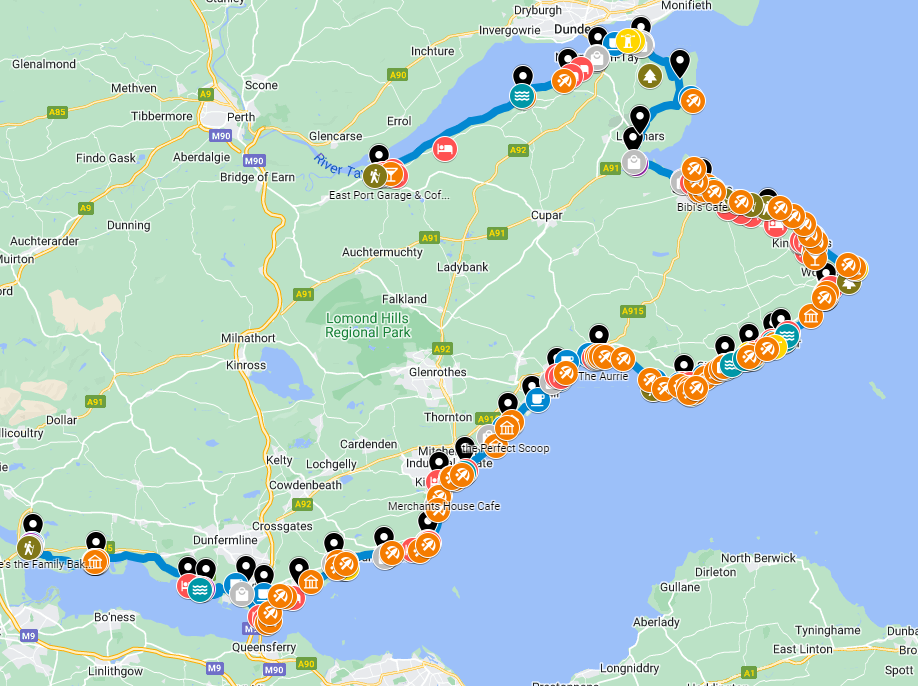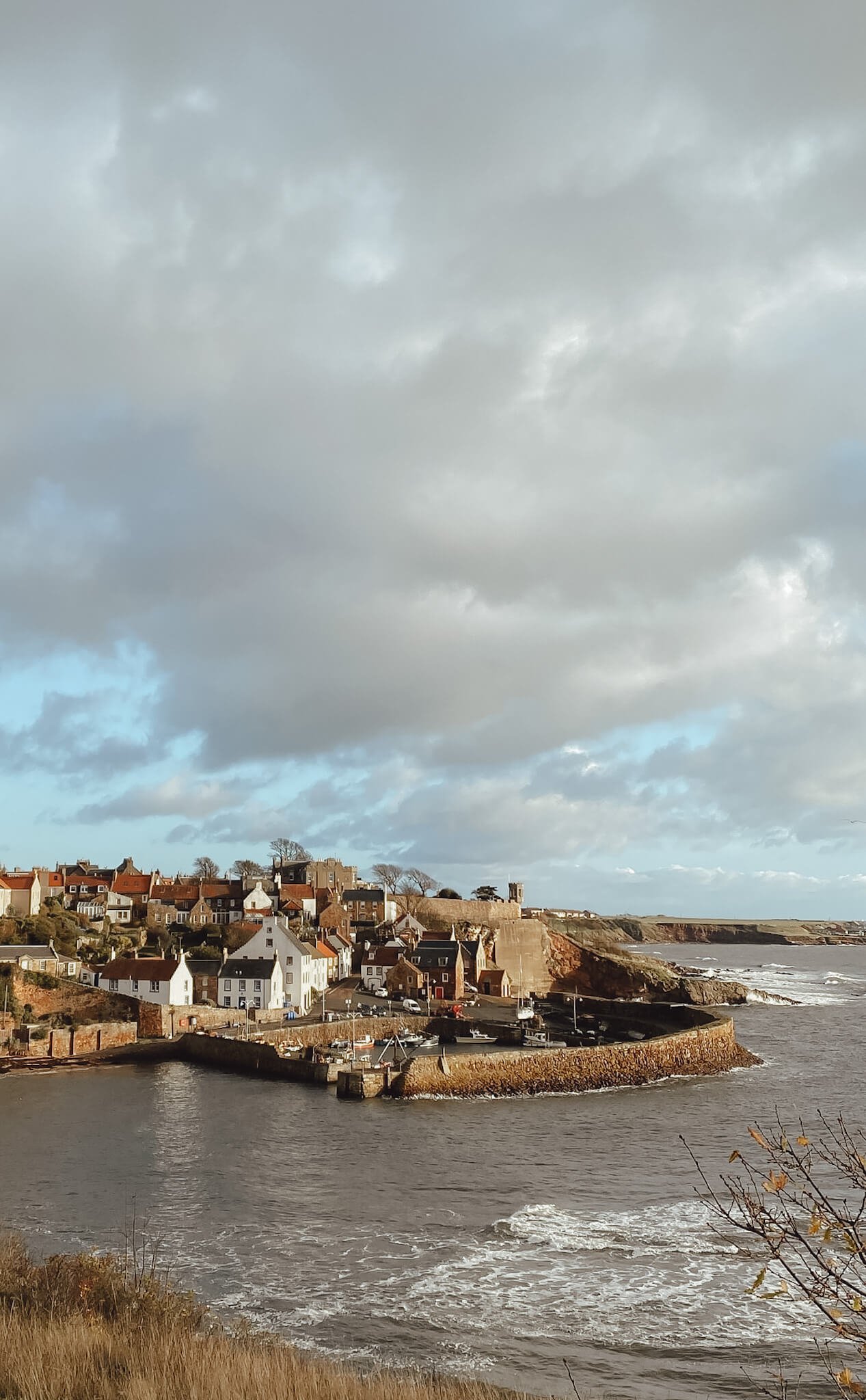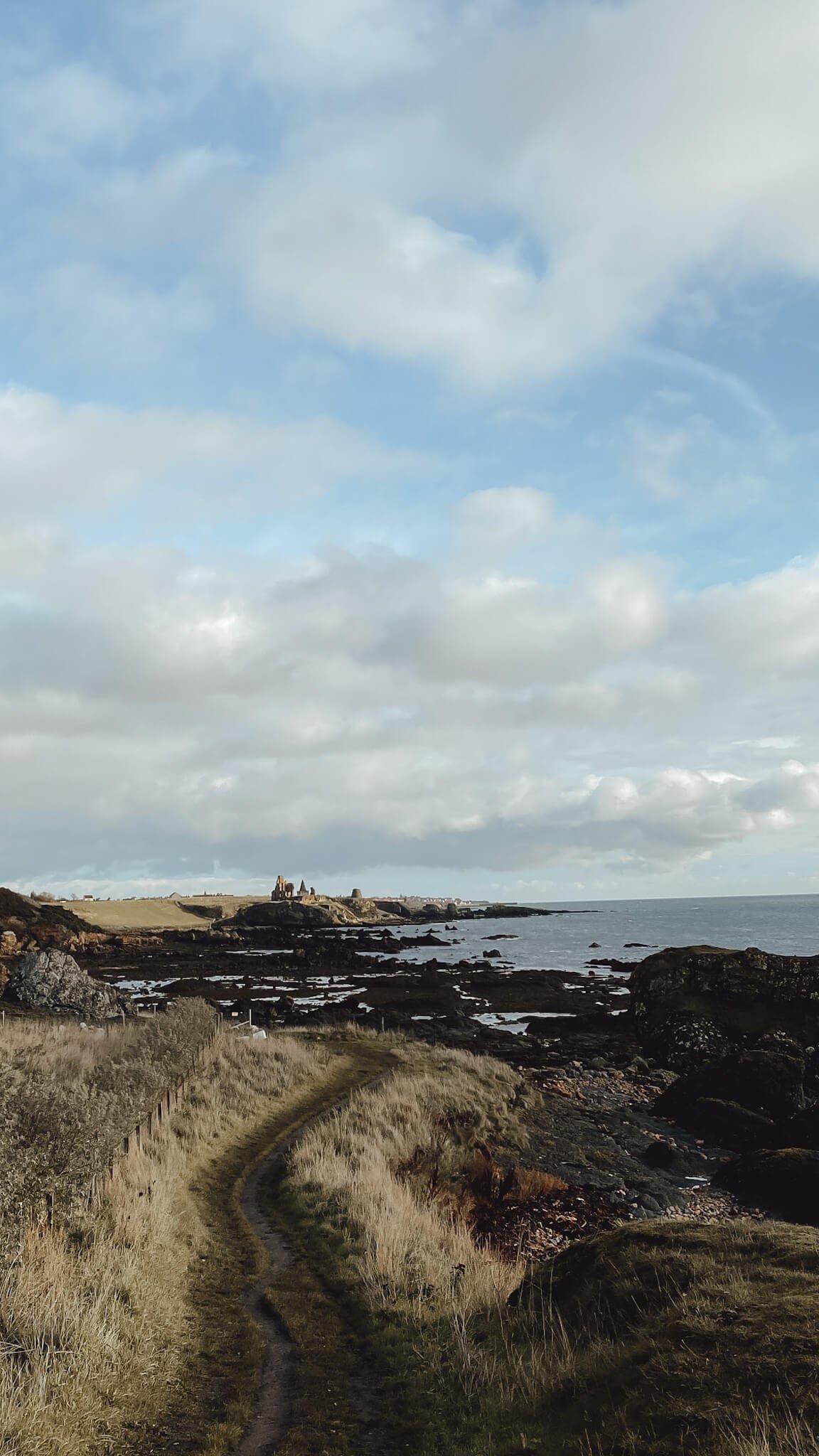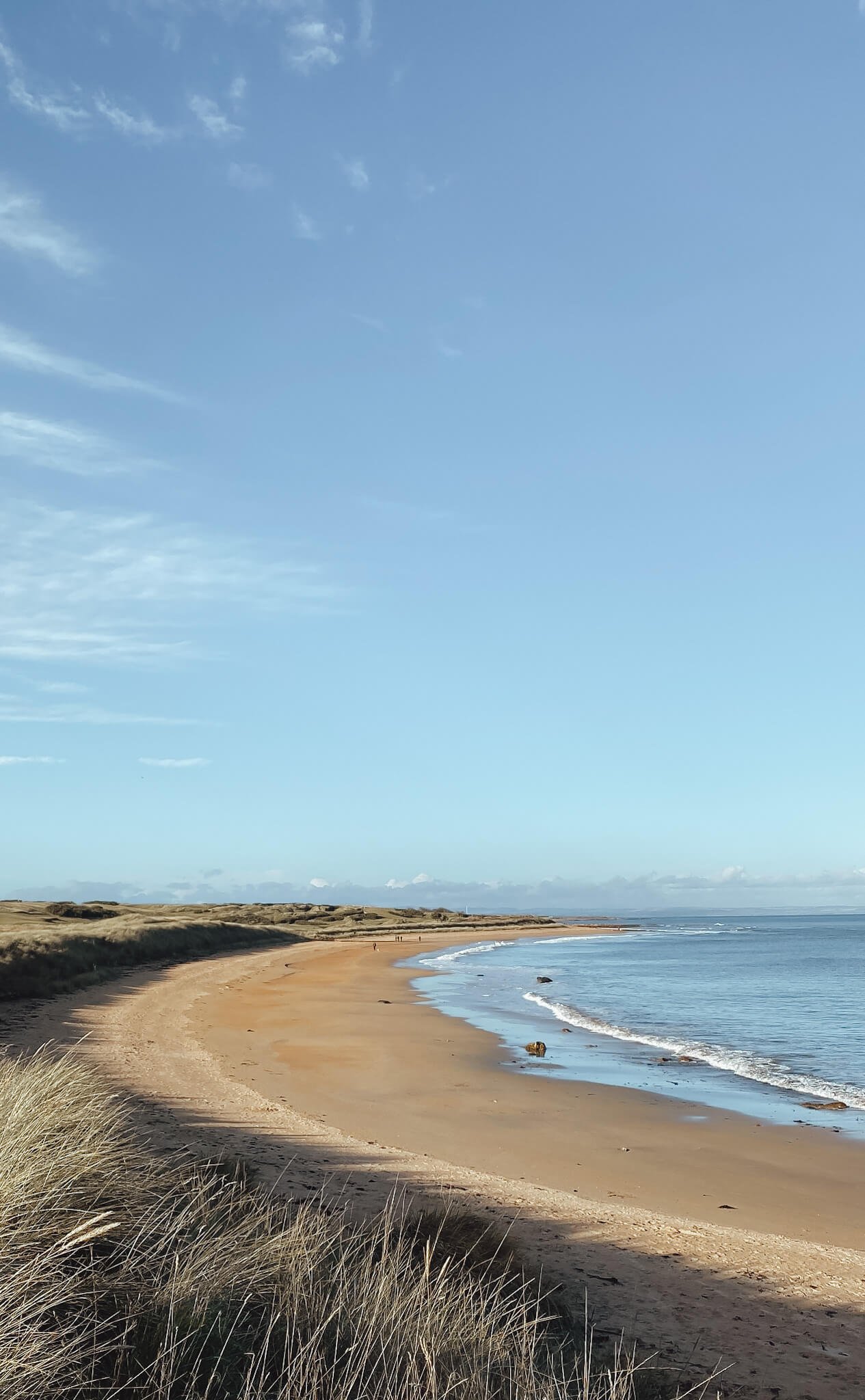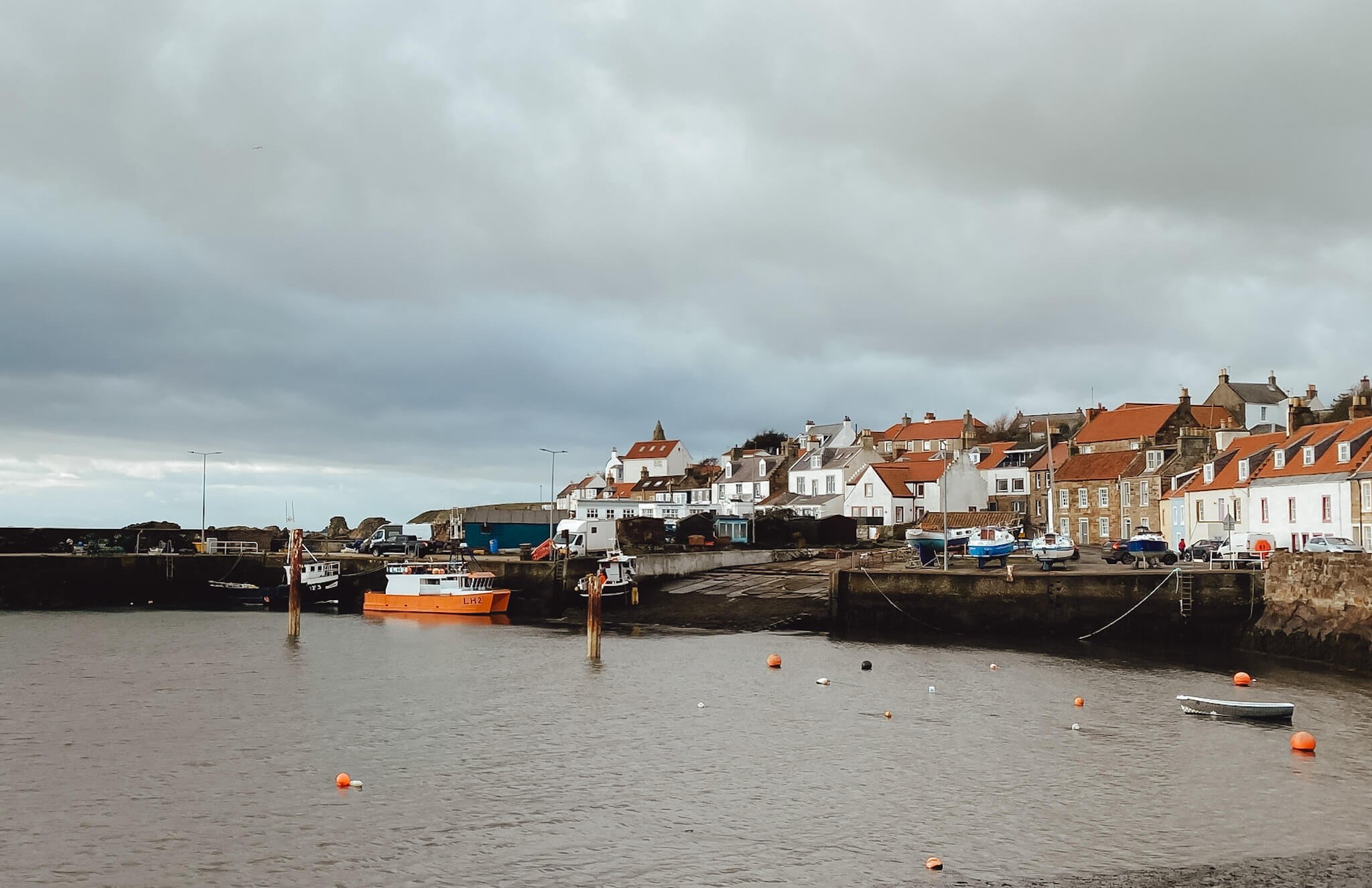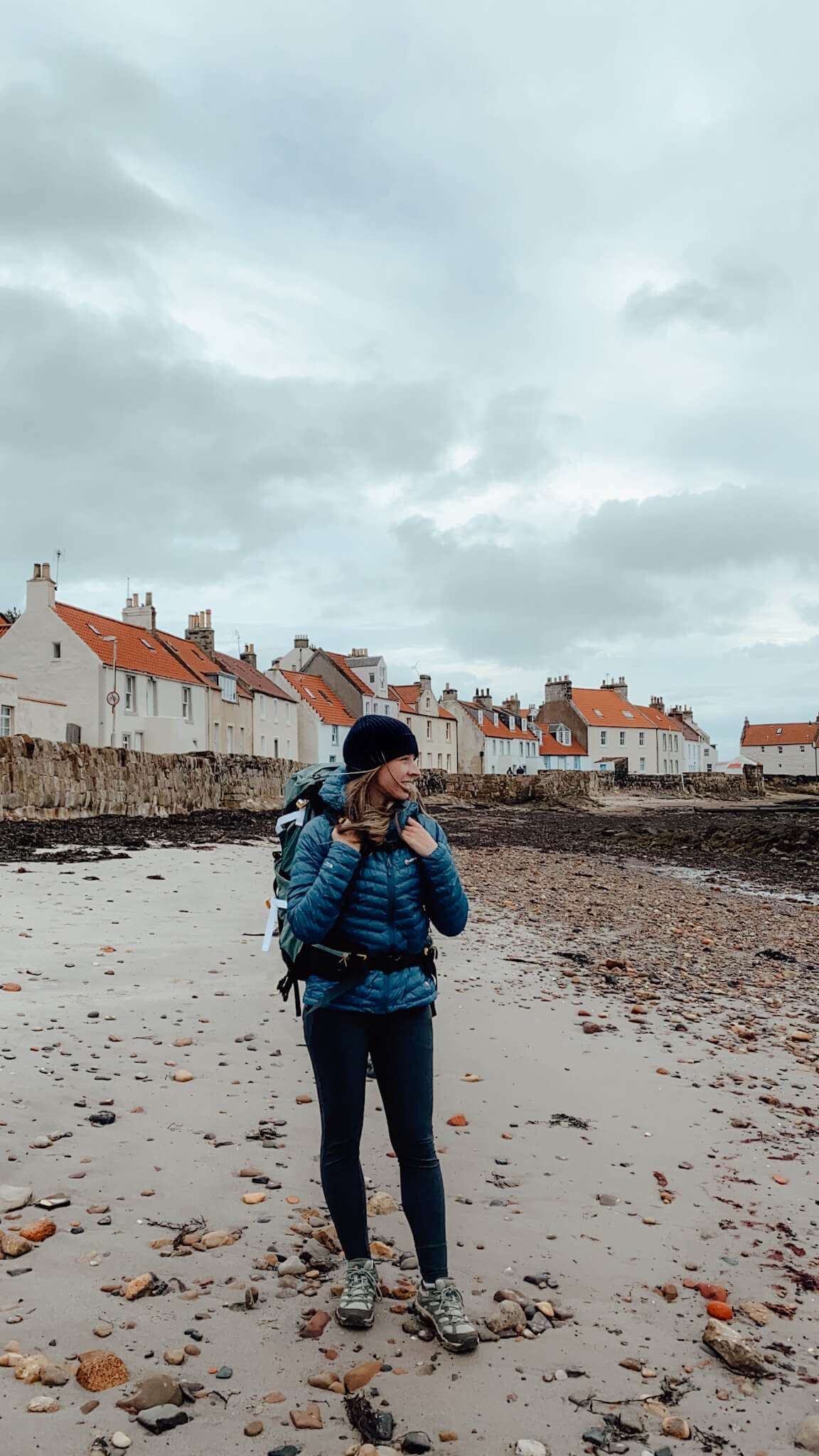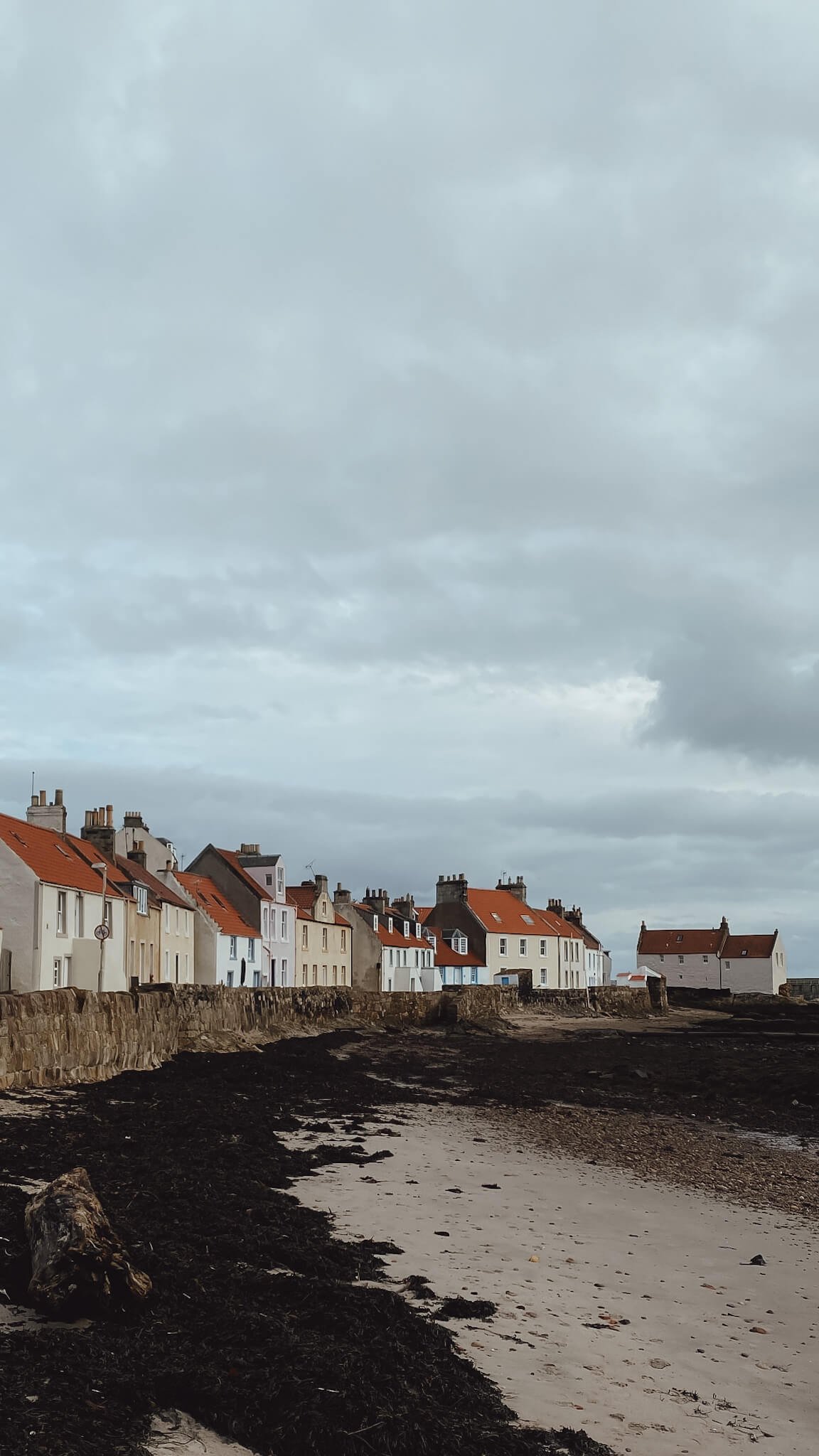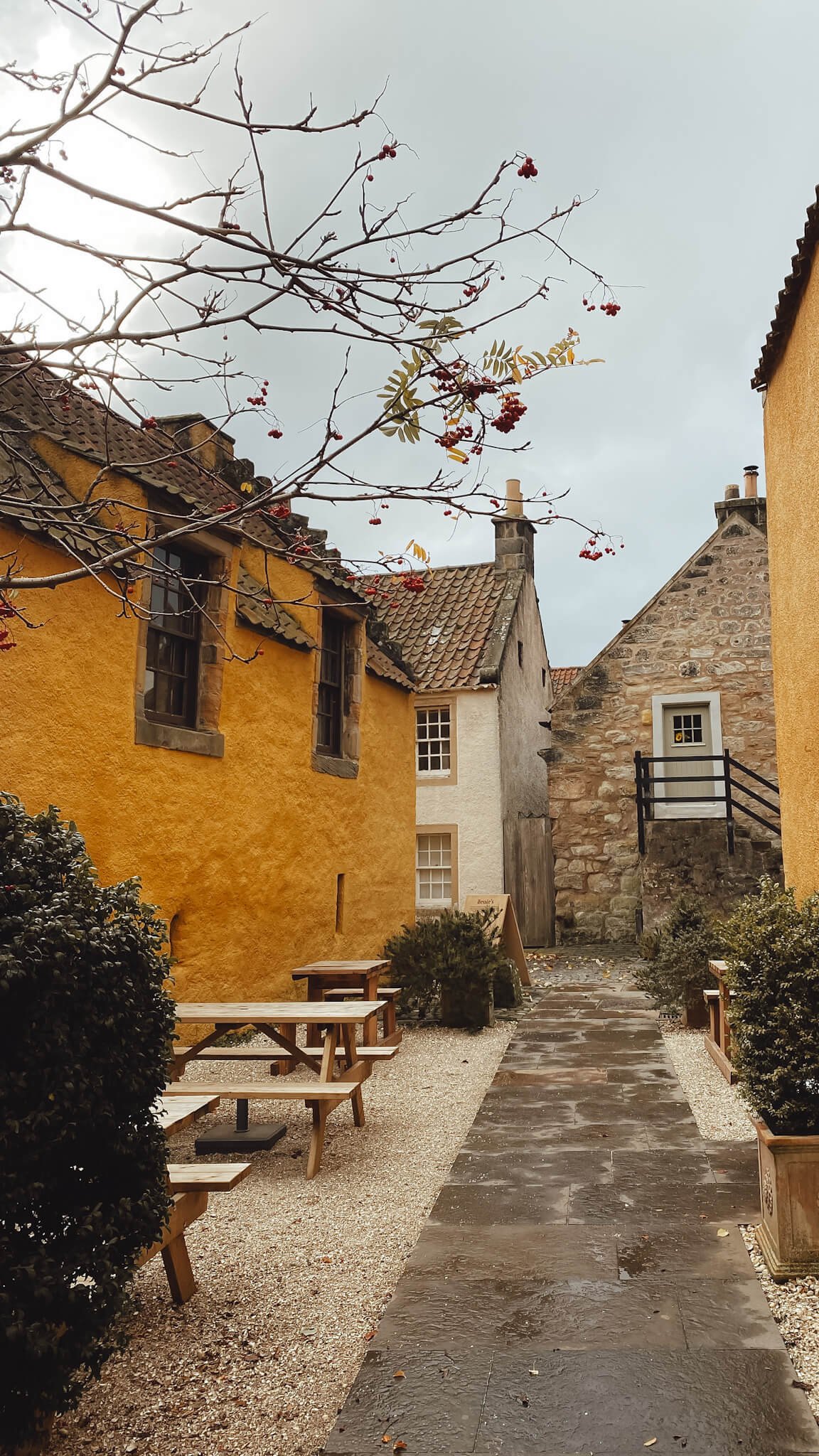Ultimate Guide To The Fife Coastal Path | Map, Route, & Itinerary
Thinking about walking the Fife Coastal Path and got questions about the route? We walked the Coastal Path three times last year, so we’ve got first-hand knowledge of everything you need to know. From where to stay and the best places to eat, where to visit and see along the route, and practical tips like finding toilets and navigating the tidal section - we’re sharing all our tips in this post.
Written by: Lesley Stewart | Updated April 2025
Although best known for its harbour villages and historic towns clustered around the sea, the Fife Coastal Path is also an incredible walking trail.
The 183km coastal path passes through some of Fife’s most beautiful landscapes and offers the opportunity to walk between ancient harbours and picture-perfect villages, over soft sandy beaches and towards steep sandstone cliffs or crumbling castle ruins.
It’s one of my favourite walks and undoubtedly one of the absolute best reasons to visit Fife.
I walked the Fife Coastal Path this year, and know everything about the trail, its difficulty, what to wear, where to eat, shop, and where to stay.
So, in this guide, I’ll share my advice for anyone looking to walk the Fife Coastal Path route – whether it’s a single section or the whole route. Including all the essentials like finding your way, the best cafes, and where to stay.
This is my ultimate guide to the Fife Coastal Path.
What is the Fife Coastal Path?
The Fife Coastal Path is a 183km official waymarked walk along the coastline of Fife, on the east of Scotland. Walking the path is a popular way to explore along the coast, with its historic towns, coastal villages, castles, beaches, and seafood.
It is also Scotland’s longest continuous coastal path.
Whilst it is by no means off the beaten track (many people walk sections of this path daily), it is one of Scotland’s lesser walked long distance route. The route starts in the town of Kincardine at the Fife Coastal Path gate and continues around the peninsula, before finishing in the village of Newburgh.
Tip / Whilst some hikers may choose to walk the Fife Coastal Path in one trip, for those seeking something shorter, there’s also the option to join the path at any stage and tackle a smaller, more accessible section. Read about these shorter options here.
No matter which you choose, both options guarantee incredible beaches, cute villages, seafood cafes, and those endless coastal views.
Fife Coastal Path route - Overview
Fife Coastal Path | 183km / 113 miles
Start point | Kincardine Archway
End point | Newburgh Archway
Kincardine - Culross - Limekilns - North Queensferry - Inverkeithing - Dalgety Bay - Aberdour - Burntisland - Kinghorn - Kirkcaldy - East Wemyss - Leven - Lower Largo - Elie - St Monans - Pittenweem - Anstruther - Crail - Kingsbarns - St Andrews - Tentsmuir Nature Reserve - Newport on Tay - Wormit Bay - Newburgh.
Fife Coastal Path Map
Looking for a comprehensive Fife Coastal Path map? I spent 9 days walking the trail and have saved 300+ my favourite cafes, restaurants, hotels, B&Bs, and scenic viewpoints, into a single map.
Plus, those all-important essential amenities like public toilets and shops.
This is an easy-to-use Google Map that you can take with you or use in advance to help plan your Fife Coastal Path walk. Click here to see my Fife Coastal Path map.
How long does it take to walk the Fife Coastal Path?
If you’re planning to walk the entire Fife Coastal Path route in one go, then allow around 8 to 10-days from start to finish. How many days you need ultimately depends on how much distance you want to cover each day and if you want to explore along the way, or simply walk through.
Your Fife Coastal Path Walking Holiday
We’ve walked the Fife Coastal Path multiple times and know exactly what it takes to walk the route, where to find the best places to stay and eat and heaps of practical information. We’re also a team of qualified guides, so we do more than just logistics - our walks are built on personal experience and designed by our expert knowledge.
Why not let us take care of the details so you can focus on immersing yourself in the breathtaking coastal landscapes.
Find out more about our FCP route planning services:
Fife Coastal Path Route
This is my Fife Coastal Path route, completed in 9 days. Some of these days are longer than I had originally planned (ideally I would’ve split day-3), however, they were very much dictated by what accommodation was available and how much time I had.
Plus, I wanted to travel through the East Neuk slowly and planned shorter walking during those days.
You can find all my favourite scenic spots, cafes, hotels, beaches, and amenities like shops & toilets in this handy Google Map.
Day 1 | Kincardine to Limekilns / 18km
Day 2 | Limekilns to Burntisland /27km
Day 3 | Burntisland to Lower Largo / 30km
Day 4 | Lower Largo to Elie / 10.5km
Day 5 | Elie to Anstruther / 10km
Day 6 | Anstruther to Crail / 7km
Day 7 | Crail to St Andrews / 21km
Day 8 | St Andrews to Newport on Tay / 29km
Day 9 | Newport on Tay to Newburgh / 27km
Fife Coastal Path Waymarkers
The Fife Coastal Path is incredibly well signposted with blue circular waymarkers all along the route. However, there are sections where these are hard to spot (usually in villages and towns), and some stretches where they are missing entirely. And whilst Google Maps is incredibly helpful for dining cafes and accommodation, it won’t always help you find the path.
I recommend downloading the OS Maps app in advance, where you can save & follow the route.
Coastal Path Fife Day trips
However, given its length, not everyone will want to complete the Fife Coastal Path route in one go.
Therefore, an alternative option is to walk the Fife Coastal Path in stages. There are numerous ways to do this, from long-weekends to more realistic daytrips, allowing you to plan stages which fit into your schedule.
Also, the vast majority of the path is covered by local bus services, to return to your car.
As a quick guide, here are some ideas on how to divide the route:
Long weekend - Walk the East Neuk section of the path, including St Andrews. You’ll want a minimum of 3-days to do this, plus an additional day if you want to explore St Andrews (which I’d recommend).
Day trip - This is a great way to experience those gorgeous coastal views and some of Fife’s most beautiful villages. Walk a section of the East Neuk, or the sand dunes between Lower Largo and Elie, or the Culross to Limekilns trail.
To find out more about shorter sections, read the best parts of the Fife Coastal Path.
Fife Coastal Path Difficulty
So long as you have a good level of fitness and walking experience, the Fife Coastal Path won’t be difficult. The hardest part for anyone walking the entire route is covering the miles through the busy urban sections, or the occasional time the path moves inland away from the coast.
There are two things you need to be aware of:
The route
When it comes to finding your way, the Fife Coastal Path is well-signposted by a combination of way markers and signage all along the route. Whilst you shouldn’t get lost, I also recommend carrying a paper or digital map for reference. Personally, I found having the route on my phone using OS Maps to be incredibly helpful.
Terrain
Once here, you’ll find that most of the path is easy going and, with the exception of a few uphill sections, the vast majority of the route is reasonably flat. Some of the route takes you through towns, where the walking is on paths. But the majority of the Fife Coastal Path follows an undulating clifftop route, most often across a narrow earthy trail.
Fife Coastal Path Tidal Section
However, being a coastal path there are occasional beach crossings and some of these are extremely rocky. This is especially true of the section between Kingsbarns and St Andrews, which is the most difficult part of the Fife Coastal Path.
Here, the route changes and becomes more challenging.
After Kingsbarns, the coastal path now cuts through a long and remote section of sandy beaches, before reaching rocky boulder fields and steep clifftop climbs. Plus, a few small rocky beaches are only accessible at, or around, low tide.
This tidal section of the Fife Coastal Path was the part I was most worried about, and I had nightmares about getting stranded. But so long as you check the tide times and walk a few hours around low tide, it’s actually incredibly straight forward.
Do your research and check the tide times for St Andrews here.
Fife Coastal Path Most Popular Walk
Everyone who walks the trail will have a favourite part, but the trail through the East Neuk, between Elie and Crail, is the most popular - especially for those walking smaller sections. This is where you’ll find the whitewashed harbour villages, cute cafes, and gorgeous coastal views.
However, if you have time, I highly recommend starting this section further back along the coast in the pretty village of Lower Largo. From there, continue through the East Neuk and around the coast to St Andrews. Whilst this longer option will take around three days, it is absolutely incredible.
You can find out more about in this guide to the best parts of the Fife Coastal Path.
Fife Coastal Path Packing List
The good news is, given the Coastal Path Fife is a straight-forward trail, you don’t need any special equipment to complete it. However, there are some items that will absolutely make your life easier and ensure you have the best experience.
The basics on what to wear and pack are:
Footwear
One thing that is absolutely necessary – whether you’re doing a day or the entire path – are appropriate shoes.
As mentioned, the route is a combination of tarmac paths in towns, clifftop trails, and beaches, all of which need comfortable and supportive footwear.
Personally, I recommend walking shoes with good grip and waterproofing, or hiking boots. On the trail, I wore these Merrell Moab 3 GTX shoes which were perfect.
Rucksack
No matter how long you’re planning to walk for, you’ll need a rucksack for packing layers, snacks, charged phone, cameras, and other essentials. This Osprey rucksack is ideal.
Wear + Pack
Waterproofs are always a sensible item to have in your bag.
Being on the coast Fife can be blustery, so pack a warm insulated jacket
For the same reason, pack a wool hat.
And a cosy fleece
A sweat wicking base layer on top.
Walking leggings or trousers.
Cushioned walking socks.
Always wear sun cream.
A power bank and mini charging cable for your phone.
Fife Coastal Path accommodation
For those walking the whole route, or multiple sections in one go, you’ll need to book accommodation.
Wild camping
Whilst wild camping is a popular choice on most of Scotland’s long-distance routes, the Fife Coastal Path is an exception to the rule.
Because the coastline is a mix of working fields, beaches, villages, or golf courses, there’s little completely wild land. So whilst camping is legal in Scotland (if you follow the outdoor code) be prepared for pitching a tent on the Fife coast to be tricky.
Where to stay
However, there are heaps of accommodation options along the Fife Coastal Path and most of the route is covered by a combination of hotels, guest houses, Airbnb, and a handful of campsites.
There are exceptions, though, where lesser-visited villages and towns have limited accommodation options - which is likely to influence your route and how much you walk on some days. Personally, there were days I walked further than I wanted to simply because the only hotel was a few more miles along the path.
Handpicked accommodation
I used Booking.com for all my Fife Coastal Path accommodation. Some of my favourite stays along the route, and the ones I recommend the most, are:
Alternatively, if you’re looking for a base, then check out Thistle Stays, which has a range of beautiful cottages and apartments for more extended stays.
Travel tip: Lastly, no matter the time of year you will absolutely want to book your accommodation for the Fife Coastal Path in advance.
Best time to walk the Fife Coastal Path
The best time to walk the coastal path Fife is April till June and September till late October.
There are fewer people around, plenty of accommodation options, plus the weather is usually at its driest and most mild.
Whilst there are pros to walking in the peak summer months (hello long, warm days) there are a few reasons for avoiding the path during July and August. Firstly, demand for accommodation in Fife in summer is high and options are limited. Also, both hotel and Airbnb prices tend to increase quite dramatically during peak months. Lastly, you’ll find pretty villages packed with people and cafes full.
For reference, I walked the Fife Coastal Path in early April and had only one day of rain, plus plenty of daylight for big walking days. Along the way, the villages and towns were at their quiet best, and I had no problem booking accommodation.
However, on the negative side it is still chilly at this time of year and some cafes and restaurants haven’t yet opened for the summer season. I’ve also walked the East Neuk section in late October and found much of the advice above still stands (though it was a little colder).
As it is entirely possible to walk the Fife Coastal Path at any time of the year, choose your month depending on what is most important to you. For example, do you hate the cold, love lots of people around, want all the cafes to be open, and so on.
What you’ll spend on the Fife Coastal Path
Whilst the Fife Coastal Path itself is free to walk, you will need to factor some costs into your plan. Though how expensive or affordable your Fife walk turns out is completely up to you. My advice is work out a budget and decide where you want to spend money in advance.
Accommodation costs
For example, my biggest cost was accommodation, because I walked the whole path and needed somewhere stay each night. From experience, Airbnb and guest houses tend to cost less than hotels. And weekends tend to be more expensive than weekdays. Factor all of this into your walk planning.
Food costs
My second biggest cost was food, because I wanted to sample the local food scene and made a point of seeking out cafes. If that’s not important to you, then there are heaps of shops along the way where you can buy inexpensive lunches and snacks. Having an Airbnb is also helpful, because they tend to come with access to a kitchen and you can make your own food.
Other costs
Some other costs to consider are:
Equipment – do you need boots, waterproofs, rucksack, poles.
Route – paper map or digital map.
Accommodation – boutique hotels vs less expensive guest houses vs Airbnb.
Food – cafes and restaurants vs shops and cooking.
Transport – taking a bus or train back to the start point.
What is there to see & do along the Fife Coastal Path?
Other than walking, there’s heaps to see and do along the Fife Coastal Path route and how much exploring you do will most definitely impact how long your walk takes. Or how many days you spend visiting the Fife coast.
There’s too much to list here, but here are some of the Fife Coastal Path highlights:
Forth Rail Bridge
Culross Palace
East Neuk villages
Isle of May boat trip
St Andrews historic town
Tentsmuir Forest
Abundance of amazing cafés, seafood shacks, and restaurants
Numerous award-winning beaches
Fife Coastal Path Resources
Resources
Coast & Countryside Trust
The entire Fife Coastal Path, including individual walk descriptions, is listed here by the Coast & Countryside Trust charity.
Their suggested stages tend to skip through some of the nicer sections too quickly however, but the interactive map is a good start point for an overview of the route and importantly it does let you know about current closures or diversions on the path.
There’s also a list of public toilets on the path which is very handy.
Welcome To Fife
Also, visit Welcome to Fife for information on the best places to eat and stay. Whilst this isn’t specific to the Coastal Path and you’ll need to do a bit of searching, each listing does come with a handy map and descriptions, and I found this resource incredibly helpful.
Tide times
Finally, the Kingsbarns to St Andrew's stage is tidal, and you’ll need to walk this at, or around, low tide. Find the tide times for Fife here.
Maps
Though there are signposts all along the Coastal Path, I found having a Fife Coastal Path map for reference was helpful. Your map options are:
I chose to use OS Maps app on my phone, which was incredibly helpful all along the route and worth £28.99. You can download OS Maps here.
Paper map users can choose a dedicated Coastal Trail map (buy it here).
Whilst Google Maps won’t help you on the trail, it is super helpful for finding cafes etc in the villages. I’ve created a Fife Coastal Path map, packed with all the best cafes, restaurants, hotels, B&Bs, scenic viewpoints, and the most beautiful beaches along the route. Plus, essential amenities like public toilets and shops. This is an easy-to-use Google Map that you can take with you to help plan your Fife Coastal Path walk.

